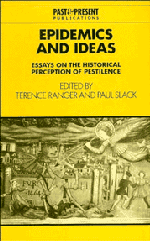Book contents
- Frontmatter
- Contents
- Contributors
- Preface
- 1 Introduction
- 2 Epidemic, ideas and classical Athenian society
- 3 Disease, dragons and saints: the management of epidemics in the Dark Ages
- 4 Epidemic disease in formal and popular thought in early Islamic Society
- 5 Plague and perceptions of the poor in early modern Italy
- 6 Dearth, dirt and fever epidemics: rewriting the history of British ‘public health’, 1780–1850
- 7 Epidemics and revolutions: cholera in nineteenth-century Europe
- 8 Hawaiian depopulation as a model for the Amerindian experience
- 9 Plague panic and epidemic politics in India, 1896–1914
- 10 Plagues of beasts and men; prophetic responses to epidemic in eastern and southern Africa
- 11 Syphilis in colonial East and Central Africa: the social construction of an epidemic
- 12 The early years of AIDS in the United Kingdom 1981–6: historical perspectives
- Index
- Past and Present Publications
9 - Plague panic and epidemic politics in India, 1896–1914
Published online by Cambridge University Press: 05 August 2011
- Frontmatter
- Contents
- Contributors
- Preface
- 1 Introduction
- 2 Epidemic, ideas and classical Athenian society
- 3 Disease, dragons and saints: the management of epidemics in the Dark Ages
- 4 Epidemic disease in formal and popular thought in early Islamic Society
- 5 Plague and perceptions of the poor in early modern Italy
- 6 Dearth, dirt and fever epidemics: rewriting the history of British ‘public health’, 1780–1850
- 7 Epidemics and revolutions: cholera in nineteenth-century Europe
- 8 Hawaiian depopulation as a model for the Amerindian experience
- 9 Plague panic and epidemic politics in India, 1896–1914
- 10 Plagues of beasts and men; prophetic responses to epidemic in eastern and southern Africa
- 11 Syphilis in colonial East and Central Africa: the social construction of an epidemic
- 12 The early years of AIDS in the United Kingdom 1981–6: historical perspectives
- Index
- Past and Present Publications
Summary
Between 1896 and 1914, bubonic plague killed over 8 million people, a modest estimate which does not allow for cases which were concealed, misdiagnosed or wrongly classified. Of all the various epidemics which afflicted India in the late nineteenth and early twentieth centuries, a Kaliyuga, a period of very high mortality, stagnant, even falling population and declining life expectancy, the plague was not the most destructive. Malaria and tuberculosis killed more than twice as many people over a similar period; in barely four months, the influenza epidemic of 1918–19 accounted for twice as many; smallpox and cholera counted their death toll in millions. Yet no other epidemic evoked the fear and panic generated by the plague.
The plague epidemic prompted massive state intervention to control its spread. It also sometimes provoked fierce resistance, riots, occasionally mob attacks on Europeans and even the assassination of British officials. The vigorous and energetic intervention of the state, in itself prompted by the general panic, bore no direct relation to the virulence of the epidemic. The focus of the state's most vigorous measures was Bombay city and its Presidency between 1896 and about 1902. But plague mortality continued to rise thereafter, reached its peak between 1903 and 1907, exceeding the levels of the late 1890s by twelvefold, and proved far more lethal in the Punjab. Yet neither plague policy nor plague riots in the Punjab appear to have displayed the zeal or acquired the political prominence they achieved in Bombay.
- Type
- Chapter
- Information
- Epidemics and IdeasEssays on the Historical Perception of Pestilence, pp. 203 - 240Publisher: Cambridge University PressPrint publication year: 1992
- 20
- Cited by

